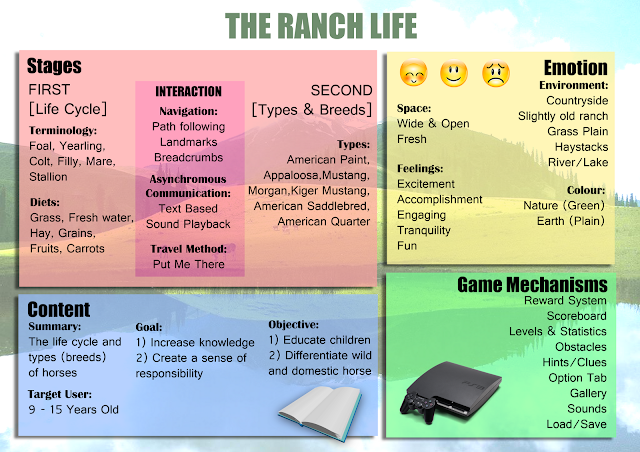 |
| White Horse |
MVR2213: Virtual Reality Design 3 (The Ranch Life)
Monday, August 27, 2012
Monday, August 13, 2012
Input, Output & Script
INPUT
|
OUTPUT
|
SCRIPT
|
Click item
|
Item appear in inventory
|
|
Click item
|
Item appear in gallery
|
|
Click item in inventory > Click Object (horse)
|
Points increase / deduct
|
|
Click object (horse)/item
|
Text popup
|
|
Walks closer to object (frame)
|
Text popup
|
|
Click button (answer)
|
Points increase/deduct & Went to the next
question
|
|
Click button (play)
|
Transferred to required level
|
Monday, August 6, 2012
Brief Research and Reference
Reference:
1) Different types of horses : http://ashleynikole.hubpages.com/hub/Different-types-of-Horses
2) Horse: http://en.wikipedia.org/wiki/Horse
3) List of horse breeds: http://en.wikipedia.org/wiki/List_of_horse_breeds
4) Horse Riding game : http://www.horseridinggame.net/equestrian-game.htm
Benchmark:
1) Different types of horses : http://ashleynikole.hubpages.com/hub/Different-types-of-Horses
2) Horse: http://en.wikipedia.org/wiki/Horse
3) List of horse breeds: http://en.wikipedia.org/wiki/List_of_horse_breeds
4) Horse Riding game : http://www.horseridinggame.net/equestrian-game.htm
Benchmark:
The grass plains (path)
Horse types
Both pictures taken from: horseridingame.net
Research:
A few types of horses that caught my eye:
The horse with the fabulous hair is called "Kiger Mustang". It said to be very intelligent (a fast learner) and can be tamed for cattle driving.
The horse with this black and white cow pattern is called "American Saddlebred". It is very suited to ride when facing a touch terrain. It could also be useful for carriage driving.
This unique cow patterned horse is called as "American Paint Horse". As the pattern suggested, it is said to have a lot of cow sense. It's suitable for Western riding since it is quick and fast.
The dalmatian patterned horse is called "Appaloosa". This horse is very versatile since it's useful for almost anything. With it's great stamina and power on the legs, it can jump and run at high speed. It has a good character and well discipline!
Project Overview (Ranch Life)
Project Title: The Ranch Life
Target Audience: Children age 9 – 15 years old
Objective:
- Educating user about the types
(breeds) and life cycle of a horse in a fun and engaging application.
- To differentiate between a
domestic and wild horse.
Description:
- On the starting page, the user
will be given a brief introduction of the application (list of instruction:
helping the user to navigate, the goal: what the user should achieve by the end
of the game, how it works: type of interaction in each level / understanding
the reward system).
- Game mechanism includes: reward
system, scoreboard, obstacles, hint/clues, level, gallery, buttons (play/next/back/cancel),
sound (effects/background).
- The game starts off with the
user in a virtual gallery. The wall of the gallery is decorated with picture of
horses in three big frames. Different option box with brief summary of a level
will appear as user walks closer to each frame. The user can decide which level they prefer to
go by clicking on the “play” button inside the option box. The user will then be
transported to the scene of the picture by “put me there” travel method.
- There are two stages (levels)
in the game which are: the life cycle of a horse and types (breeds) of horses.
- The first stage (life cycle of
a horse): Users are placed in a ranch type environment (grass plains, wooden
fence, haystack) where they could interact with various ages of horses (Foal/Yearling/Colt/Filly/Mare/Stallion).
Information and trivia is given to the users by asynchronous communication
method, where text would pop out as users walk around the environment. The
navigation type in this stage is wayfinding. Path following and landmarks are
used in helping navigating the users around the application. The interaction in
this stage involves feeding the horses and scavenger hunt around the
environment to increase their points (reward system).
- The second stage (horses types
and breeds): Users are placed in a long path guarded by wooden fence. Beside the
fence, horses are seen roaming around the grass plains. As users walk down the
path, facts and trivia regarding type of horses are provided to the users (asynchronous
communication). Users navigate around with path following and bread crumbs as a
guide throughout this stage. The interaction is limited to picking up objects
and jumping along the way. By the end of the stage, users are given a pop quiz
taken from the earlier information to increase their points and to complete the
game.
- The stats (points, time taken
and mystery item) of the user are saved by the end of the game. The user could play
again and to completed their gallery slots.
Subscribe to:
Posts (Atom)
























